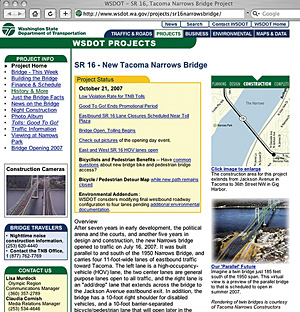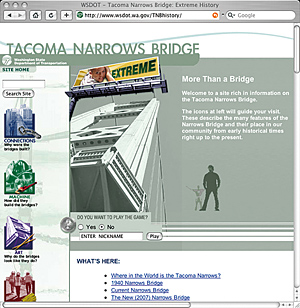Overseas News on Civil Engineering IT
|
|
This section focuses on a unique overseas web site related to civil engineering IT. This issue features one of the web sites of WSDOT (Washington State Department of Transportation), "SR (State Route) 16 Tacoma Narrows Bridge Project," dispatching wide range of information specialized on the new bridge that opened in July 2007.
Built Parallel to 1950 Bridge, New Bridge Opened to Traffic on July 16, 2007
Current Bridge Retrofit will be Completed in spring 2008
After seven years in early development, and another five years in design (from September 2002) and construction (from January 2003), the new Narrows Bridge opened to traffic on July 16, 2007.
The event that made the Tacoma Narrows Bridge remain in the memories of many people in bridge industry was a dramatic failure of the older bridge 67 years ago. This is explained in "History and More" page in the web site from various points of view. According to Ms. Claudia Cornish, WSDOT Tacoma Narrows Bridge Communications Manager, Media Relations, this part is intended for 7th grade (13 - 14 year-old) kids. It contains historical descriptions that follow the changes from the time of native people and settlement of Europeans, the beginning of exchange across the Narrows that divide the lands, needs for constructing a bridge that connects the mainland with Kitsap Peninsula, and various proposals provided to reflect the needs.
Resulting from these circumstances, the Tacoma Narrows Bridge, boasting the third longest suspension span in the world at the time opened on July 1st, 1940.The Bridge was described as stretching like a steel ribbon. Only four months later, however, that graceful bridge collapsed, sinking to the bottom of the Narrows. With "Galloping Gertie" as its nickname, the disaster was recorded as a movie. On the other hand, "The most dramatic failure in bridge engineering history" of the structure based on the advanced technology of the time is now positioned to have brought about a great change to suspension bridge design, promoting technological improvement up to the present.
10 years later, taking the previous experience into account, a new and much safer Tacoma Narrows Bridge opened on Oct. 14, 1950. Since then, as a half century passes, traffic flow increased gradually as well. As a measure to mitigate this, lively discussion heated on the options of reconstruction of the bridge and the construction of the second structure. In 1998, according the web site, the public was asked if Narrows Bridge should be modified and a parallel bridge constructed, financed by tolls on bridge traffic and operated as a public-private partnership. A majority of the voters agreed on the proposal, making this project get started. WSDOT made an order according to design-build system, and Tacoma Narrows Contractors (TNC) accepted the order. Following this, in 2002, WSDOT and TNC started design work. The main processes of the project after that are summarized in "Finance & Schedule" in the web site, including the opening of the new bridge in summer 2007 and projected completion of retrofit work of the 1950 bridge in spring 2008,.
Utilizing Animation to Visualize Technological Challenges
One of the main roles played by the web site for the project is visualization of technological challenges that are difficult to see or conducted unnoticeably.
Take "Building the Bridge" for instance. On the top of the page is placed an illustration of a suspension bridge with the terms like CAISSONS, TOWER, CABLE, DECK, and ANCHORAGE. Placing a cursor on any of those words, the word and the corresponding part of the illustration will turn red. With a single click, it will jump to the specialized page for each structural element, offering its detailed explanation. The page is linked with a glossary at the end of the page. It seems to give thoughtful attention so that everyone can get deeper understanding about the project in this site.
In addition, from "New Bridge Project 2002 to 2008" of Photo Album, lots of pictures can be viewed with captions, including explanations of each structural element. From "Animated Files" of the same Photo Album, image data to represent virtual scenes of bridge construction created by CG (Computer Graphics) animation can be downloaded. CG animation is especially expected to be potential as an effective means of explanation, as it is able to realistically describe the work on sea floor or high places that could not be seen usually, as well as to show the complete image of a bridge in advance.
In this sense, animation is effectively used on the "Easy To Use" page in order to explain the mechanism of a new toll system "Good To Go!" In the state of Washington, tolls started being collected for a new bridge (a part of a state road) for the first time after 22 years with introduction of a unique ETC system "Good To Go!" Making the best use of movie, this site is able to simulate how the new system works in the real situation.
Besides, "Construction Cameras" page offers live images of changing situations of construction by web cameras located on each site. This part is rich in various information such as traffic information on the surrounding I-5 (Interstate Highway 5) or SR 16, or night construction information with which local residents are highly concerned.
 |
 |
 Top page: Top page: Washington State Department of Transportation (WSDOT) SR16 Tacoma Narrows Bridge Project(Reproduced by courtesy of WSDOT) |
 Top screen of History & More Top screen of History & More(Reproduced by courtesy of WSDOT) |
This article is written based on the above web site with the permission of WSDOT.


